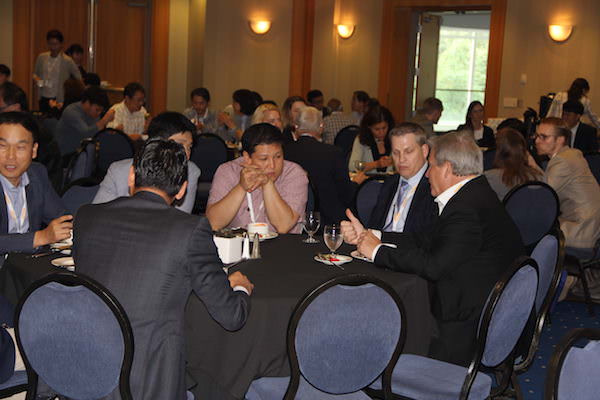
[Image above] MCARE 2018 attendees enjoy networking during lunch. Credit: ACerS
Nearly two hundred people from South Korea, Canada, the United States, and 22 other countries converged in Vancouver, BC, Canada, August 20–23, for Materials Challenges in Alternative and Renewable Energy (MCARE 2018).
MCARE 2018 showcased the work of the world’s leading scientists seeking to develop materials with increased performance, higher mechanical strength, longer environmental durability, and other short- and long-term property enhancements required to make these technologies viable.
Subhash Singhal kicked off the meeting with an excellent overview of solid oxide fuel cells. Drawing on the wealth of his experiences at Westinghouse and the Pacific Northwest National Laboratory, Singhal discussed the how the challenges of power density, fuel and air separation, temperature tradeoffs, and materials developments meet various temperature and technological challenges. Singhal provided a hopeful picture for solid oxide fuel cells, highlighting companies active in producing and purchasing devices, along with measures of energy produced by SOFCs.
A number of presentations and posters on both solid oxide fuel cells and solid oxide electrolysis complemented Singhal’s plenary. Solid oxide electrolysis uses similar materials to fuel cells. However, SOE converts water, carbon dioxide, and other gases into energy-carrying and raw-material gases such as hydrogen or carbon monoxide using electricity—ideally excess solar and wind energy. Among the challenges discussed were new materials and new structures for electrodes such as nanofibrous cathodes.

A student explains her research during the poster session. Credit: ACerS
Speaking of solar energy, Tsotomu Myasaka from Toin University of Yokohama began Tuesday with the historic and current uses of perovskites for solar energy and other applications. His group’s work on organic lead halides has led to materials with over 23% efficiency for directly converting solar energy to electricity. This is a significant advancement in a field where most technologies are closer to 15% efficient.
However, as is the theme of MCARE 2018, organic lead halides have their challenges, including the instability of the organic component and, obviously, the use of lead. So while this material may not be ideal for solar cell applications, Myasaka described its use in full color imaging and X-ray detectors and provided insights into future research such as replacing the organics with cesium.
Among the more creatively named presentations at MCARE was Firing up perovskite solar modules. Bert Conings from Hasselt University detailed significant engineering testing simulating the performance of these modules during building fires. His results pointed towards potential ways to mitigate the lead hazard until alternate materials can be found.

MCARE 2018 attendees listened to a wide range of topics about materials and renewable energy solutions. Credit: ACerS
Sustainable supply and lifecycle analysis was another major engineering topic for the meeting. MCARE 2018 coorganizer Gabrielle Gaustad led sessions with topics on determining optimal methods for recycling important materials such as rare earths, which tend to be present in relatively small amounts in devices. Presenters discussed various models of recovery from disassembly and reuse of parts to chemical methods for extracting raw materials from shredded devices. This most interesting seminar also highlighted risk reduction for raw materials.
The theme of designing materials for sustainability continued throughout the plenary sessions on Wednesday and Thursday. On Wednesday Yang-Kook Sun from Hanyang University discussed new designs and compositions for lithium battery cathodes. On Thursday, Hideo Hosono from the Tokyo Institute of Technology provided a broad perspective on 12CaO-7Al2O3, a material consisting of low-cost, abundant elements that has an amazing range of properties for advanced and renewable energy applications.
Presenters discussed additional topics in alternate and renewable energy, including optimizing electrical and thermal conductivities in thermoelectrics, new materials for solar water splitting (direct hydrogen generation from solar irradiation), advances in photonic, ferroelectric, and catalytic materials, and more. One fascinating presentation was about thermionic propulsion for missions to Mars and beyond.
Beyond the interesting technical presentations, MCARE 2018 offered many opportunities for camaraderie and networking. The opening reception included networking lunches, coffee breaks, poster session, and many great discussions.

Yoon-Bong Hahn and Steven Tidrow present Won Gyu Lee, head of the KIChE materials division, with ACerS certificate of appreciation. Credit: ACerS
A special Korean Institute of Chemical Engineers (KIChE) appreciation luncheon highlighted the strength of cooperation between ACerS and KIChE. Yoon-Bong Hahn, a coorganizer representing KIChE, described MCARE 2018 as “having great energy, with excellent presentations and opportunities for interaction with luminaries in our fields.” He encourages researchers from Europe and the Americas to attend the next MCARE meeting at Jeju Island in South Korea “to see activities from and participate in cross-collaborations with researchers from China, Singapore, Malaysia, Japan, Korea, and many other Asian countries.”
MCARE’s lead coorganizer Steven Tidrow summed up the meeting very well. He was “energized by the enthusiasm and high level of science and engineering discussions and honored to be part of a cohort of colleagues interested in making the world’s energy supply more sustainable.”

Meeting organizers and plenary speaker (left to right): Michitaka Ohtaki, Gabrielle Gaustad, Subhash Singhal, Steven Tidrow, Yoon-Bong Hahn, and Sanjay Mathur. Credit: ACerS
To view more photos of MCARE 2018, visit the Flickr page.
Want to read more articles like this? Subscribe to the Ceramic Tech Today newsletter to continue to receive the latest news in the ceramic and glass industry right in your inbox! Visit this link to get started.
Author
Jonathon Foreman
Spotlight Categories
- Meeting Highlights
Divisions
- Energy Materials and Systems
Related Posts
Volunteer spotlight: Hyunjun Kim
December 18, 2025
ACerS GOMD History – A Look Back in Time
December 10, 2025


